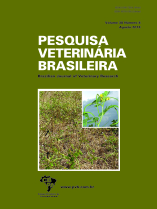 |
|
|
|
Year 2018 - Volume 38, Number 8
|

|
Clinical and pathological findings and control methods of the poisoning by Pteridium (aquilinum) arachnoideum in a farm of Rio Grande do Sul, Brazil, 38(8):1584-1596
|
ABSTRACT.- Boabaid F.M., Oliveira L.G.S., Dalto A.G.C., Bandarra P.M., Souza F.S., Sonne L. & Driemeier D. 2018. [Clinical and pathological findings and control methods of the poisoning by Pteridium (aquilinum) arachnoideum in a farm of Rio Grande do Sul, Brazil.] Achados clínico-patológicos e métodos de controle da intoxicação por Pteridium (aquilinum) arachnoideum em uma propriedade do Rio Grande do Sul. Pesquisa Veterinária Brasileira 38(8):1584-1596. Setor de Patologia Veterinária, Faculdade de Veterinária, Universidade Federal do Rio Grande do Sul, Av. Bento Gonçalves 9090, Porto Alegre, RS 91540-000, Brazil. E-mail: davetpat@ufrgs.br
The infestation of pastures by populations of Pteridium arachnoideum has been a considerable and global problem to the livestock production, due to animal mortality and pasture coverage reduction. Given the impact of P. arachnoideum on cattle production, it has been proposed to monitor a beef cattle farm in Rio Grande do Sul, to assess some of the losses associated with the plant consumption and the methods employed for the plant control. A survey of cattle deaths associated with fern poisoning on the farm was carried out from January 2007 to January 2015. In addition, the viability of sheep as a biological control tool was tested. Attempts to control the plant through the use of the herbicides methylsulfuron‑methyl and picloram associated or not with previous mowing were monitored. Cases of natural poisoning observed in the farm included the acute form (22), known as hemorrhagic diathesis as well as the chronic form, consisting in digestive carcinomas (6). Five cases of hemorrhagic diathesis in young cattle went along with marked laryngeal edema, which was clinically manifested as dyspnea and roaring, in addition to the classic pathological changes of widespread hemorrhages and infarcts. Even though less frequent, upper digestive tract carcinomas caused significant losses, due to annual mortality of mature cows. In occasions, when cattle were moved to newly mowed infested areas, outbreaks of acute poisoning were observed. The attempted control by sheep introduction showed to be unpractical, due to the little consumption seen at a stocking rate of four sheep per hectare. However, sheep mortality due to P. arachnoideum consumption was not recorded. The plant control method applied at the farm is based on both, the mowing of densely populated areas and the use of herbicides, namely metylsulfuron-methyl and picloram, in all paddocks. The reduction of P. arachnoideum coverage showed to be varied in different paddocks, however allowed the recovery of some grazing areas. This practice needs further studies, as some areas have not had satisfactory pasture recovery, and its indiscriminate use could lead to environmental impacts and resistance of P. arachnoideum to herbicides. |
| |
|
|
| |
|
 |